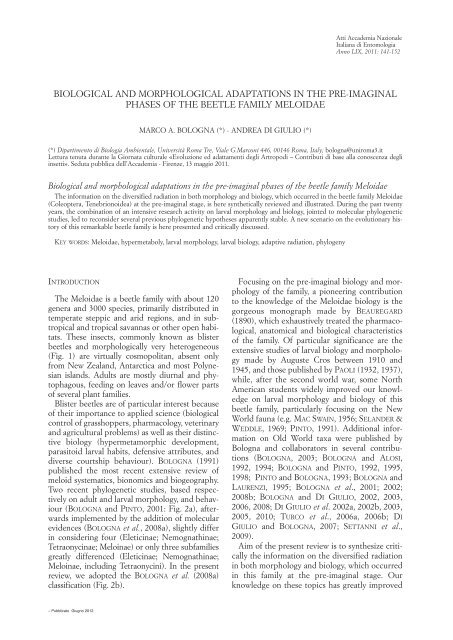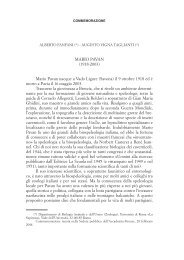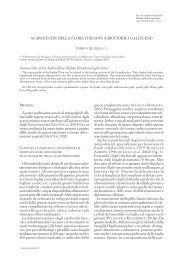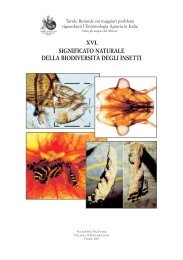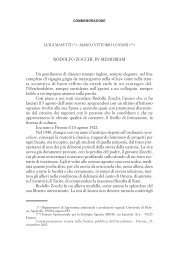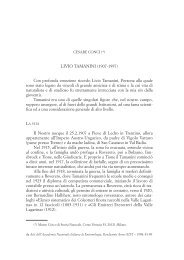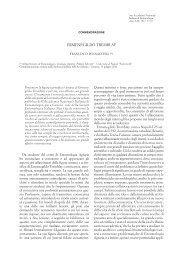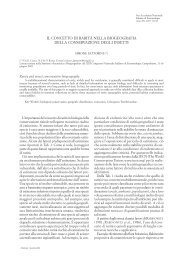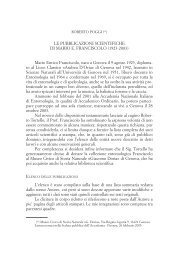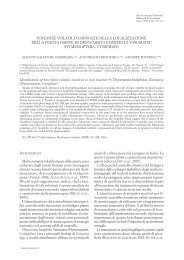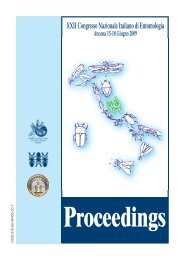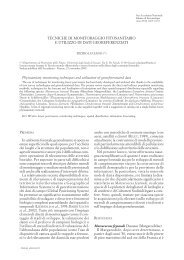Biological and morphological adaptations in the pre-imaginal
Biological and morphological adaptations in the pre-imaginal
Biological and morphological adaptations in the pre-imaginal
You also want an ePaper? Increase the reach of your titles
YUMPU automatically turns print PDFs into web optimized ePapers that Google loves.
Atti Accademia Nazionale<br />
Italiana di Entomologia<br />
Anno LIX, 2011: 141-152<br />
BIOLOGICAL AND MORPHOLOGICAL ADAPTATIONS IN THE PRE-IMAGINAL<br />
PHASES OF THE BEETLE FAMILY MELOIDAE<br />
MARCO A. BOLOGNA (*) - ANDREA DI GIULIO (*)<br />
(*) Dipartimento di Biologia Ambientale, Università Roma Tre, Viale G.Marconi 446, 00146 Roma, Italy; bologna@uniroma3.it<br />
Lettura tenuta durante la Giornata culturale «Evoluzione ed adattamenti degli Artropodi – Contributi di base alla conoscenza degli<br />
<strong>in</strong>setti». Seduta pubblica dell’Accademia - Firenze, 13 maggio 2011.<br />
<strong>Biological</strong> <strong>and</strong> <strong>morphological</strong> <strong>adaptations</strong> <strong>in</strong> <strong>the</strong> <strong>pre</strong>-imag<strong>in</strong>al phases of <strong>the</strong> beetle family Meloidae<br />
The <strong>in</strong>formation on <strong>the</strong> diversified radiation <strong>in</strong> both morphology <strong>and</strong> biology, which occurred <strong>in</strong> <strong>the</strong> beetle family Meloidae<br />
(Coleoptera, Tenebrionoidea) at <strong>the</strong> <strong>pre</strong>-imag<strong>in</strong>al stage, is here syn<strong>the</strong>tically reviewed <strong>and</strong> illustrated. Dur<strong>in</strong>g <strong>the</strong> past twenty<br />
years, <strong>the</strong> comb<strong>in</strong>ation of an <strong>in</strong>tensive research activity on larval morphology <strong>and</strong> biology, jo<strong>in</strong>ted to molecular phylogenetic<br />
studies, led to reconsider several <strong>pre</strong>vious phylogenetic hypo<strong>the</strong>ses apparently stable. A new scenario on <strong>the</strong> evolutionary history<br />
of this remarkable beetle family is here <strong>pre</strong>sented <strong>and</strong> critically discussed.<br />
KEY WORDS: Meloidae, hypermetaboly, larval morphology, larval biology, adaptive radiation, phylogeny<br />
INTRODUCTION<br />
The Meloidae is a beetle family with about 120<br />
genera <strong>and</strong> 3000 species, primarily distributed <strong>in</strong><br />
temperate steppic <strong>and</strong> arid regions, <strong>and</strong> <strong>in</strong> subtropical<br />
<strong>and</strong> tropical savannas or o<strong>the</strong>r open habitats.<br />
These <strong>in</strong>sects, commonly known as blister<br />
beetles <strong>and</strong> <strong>morphological</strong>ly very heterogeneous<br />
(Fig. 1) are virtually cosmopolitan, absent only<br />
from New Zeal<strong>and</strong>, Antarctica <strong>and</strong> most Polyne -<br />
sian isl<strong>and</strong>s. Adults are mostly diurnal <strong>and</strong> phytophagous,<br />
feed<strong>in</strong>g on leaves <strong>and</strong>/or flower parts<br />
of several plant families.<br />
Blister beetles are of particular <strong>in</strong>terest because<br />
of <strong>the</strong>ir importance to applied science (biological<br />
control of grasshoppers, pharmacology, veter<strong>in</strong>ary<br />
<strong>and</strong> agricultural problems) as well as <strong>the</strong>ir dist<strong>in</strong>ctive<br />
biology (hypermetamorphic development,<br />
parasitoid larval habits, defensive attributes, <strong>and</strong><br />
diverse courtship behaviour). BOLOGNA (1991)<br />
published <strong>the</strong> most recent extensive review of<br />
meloid systematics, bionomics <strong>and</strong> biogeography.<br />
Two recent phylogenetic studies, based respectively<br />
on adult <strong>and</strong> larval morphology, <strong>and</strong> behaviour<br />
(BOLOGNA <strong>and</strong> PINTO, 2001: Fig. 2a), afterwards<br />
implemented by <strong>the</strong> addition of molecular<br />
evidences (BOLOGNA et al., 2008a), slightly differ<br />
<strong>in</strong> consider<strong>in</strong>g four (Eletic<strong>in</strong>ae; Nemognath<strong>in</strong>ae;<br />
Tetraonyc<strong>in</strong>ae; Melo<strong>in</strong>ae) or only three subfamilies<br />
greatly differenced (Eletic<strong>in</strong>ae; Nemognath<strong>in</strong>ae;<br />
Melo<strong>in</strong>ae, <strong>in</strong>clud<strong>in</strong>g Tetraonyc<strong>in</strong>i). In <strong>the</strong> <strong>pre</strong>sent<br />
review, we adopted <strong>the</strong> BOLOGNA et al. (2008a)<br />
classification (Fig. 2b).<br />
– Pubblicato Giugno 2012<br />
Focus<strong>in</strong>g on <strong>the</strong> <strong>pre</strong>-imag<strong>in</strong>al biology <strong>and</strong> morphology<br />
of <strong>the</strong> family, a pioneer<strong>in</strong>g contribution<br />
to <strong>the</strong> knowledge of <strong>the</strong> Meloidae biology is <strong>the</strong><br />
gorgeous monograph made by BEAUREGARD<br />
(1890), which exhaustively treated <strong>the</strong> pharmacological,<br />
anatomical <strong>and</strong> biological characteristics<br />
of <strong>the</strong> family. Of particular significance are <strong>the</strong><br />
extensive studies of larval biology <strong>and</strong> morphology<br />
made by Auguste Cros between 1910 <strong>and</strong><br />
1945, <strong>and</strong> those published by PAOLI (1932, 1937),<br />
while, after <strong>the</strong> second world war, some North<br />
American students widely improved our knowledge<br />
on larval morphology <strong>and</strong> biology of this<br />
beetle family, particularly focus<strong>in</strong>g on <strong>the</strong> New<br />
World fauna (e.g. MAC SWAIN, 1956; SELANDER &<br />
WEDDLE, 1969; PINTO, 1991). Additional <strong>in</strong>formation<br />
on Old World taxa were published by<br />
Bologna <strong>and</strong> collaborators <strong>in</strong> several contributions<br />
(BOLOGNA, 2003; BOLOGNA <strong>and</strong> ALOSI,<br />
1992, 1994; BOLOGNA <strong>and</strong> PINTO, 1992, 1995,<br />
1998; PINTO <strong>and</strong> BOLOGNA, 1993; BOLOGNA <strong>and</strong><br />
LAURENZI, 1995; BOLOGNA et al., 2001; 2002;<br />
2008b; BOLOGNA <strong>and</strong> DI GIULIO, 2002, 2003,<br />
2006, 2008; DI GIULIO et al. 2002a, 2002b, 2003,<br />
2005, 2010; TURCO et al., 2006a, 2006b; DI<br />
GIULIO <strong>and</strong> BOLOGNA, 2007; SETTANNI et al.,<br />
2009).<br />
Aim of <strong>the</strong> <strong>pre</strong>sent review is to syn<strong>the</strong>size critically<br />
<strong>the</strong> <strong>in</strong>formation on <strong>the</strong> diversified radiation<br />
<strong>in</strong> both morphology <strong>and</strong> biology, which occurred<br />
<strong>in</strong> this family at <strong>the</strong> <strong>pre</strong>-imag<strong>in</strong>al stage. Our<br />
knowledge on <strong>the</strong>se topics has greatly improved
<strong>in</strong> <strong>the</strong> last twenty years, allow<strong>in</strong>g at a new scenario<br />
surpris<strong>in</strong>gly amend<strong>in</strong>g several <strong>pre</strong>vious<br />
hypo<strong>the</strong>ses.<br />
GENERAL INFORMATION ON PRE-IMAGINAL<br />
BIOLOGY OF MELOIDAE<br />
In <strong>the</strong> subfamily Melo<strong>in</strong>ae eggs are placed <strong>in</strong> <strong>the</strong><br />
soil, while <strong>in</strong> <strong>the</strong> Tetraonyc<strong>in</strong>i <strong>and</strong> <strong>in</strong> Nemogna -<br />
th<strong>in</strong>ae are laid under flowers, bracts, or <strong>in</strong> a few taxa<br />
(Hori<strong>in</strong>i, some Sitaris Latreille, Stenoria Mulsant,<br />
Allendesalazaria Mart<strong>in</strong>ez de la Escalera) <strong>in</strong>side<br />
<strong>the</strong>ir host nests or under stones (Tricrania LeConte)<br />
(BOLOGNA 1991). The only studied species of <strong>the</strong><br />
basal Eletic<strong>in</strong>ae subfamily (Eletica wahlbergi<br />
Fahraeus), oviposits under barks by an ovipositor,<br />
which lacks <strong>in</strong> <strong>the</strong> most derived subfamilies (PINTO<br />
et al., 1996), while <strong>in</strong> <strong>the</strong> sou<strong>the</strong>rn African genus<br />
Iselma Haag-Rutenberg, oviposition on shrubby<br />
plants is suspected (BOLOGNA et al., 2001).<br />
No <strong>in</strong>formation is available on <strong>the</strong> larval food of<br />
<strong>the</strong> Eletic<strong>in</strong>ae, but <strong>in</strong> <strong>the</strong> genus Eletica Dejean, it<br />
could consist of larvae of o<strong>the</strong>r <strong>in</strong>sects occurr<strong>in</strong>g<br />
– 142 –<br />
Fig. 1.<br />
Morphological diversity of blister beetles. Eletic<strong>in</strong>ae, Deride<strong>in</strong>i: Iselma flavipennis (a); Nemognath<strong>in</strong>ae, Nemognath<strong>in</strong>i: Zonitis<br />
immaculata (b), Zonitoschema cfr. cocc<strong>in</strong>ea (c); Melo<strong>in</strong>ae, Lytt<strong>in</strong>i: Lydus sangu<strong>in</strong>ipennis (d), Berberomeloe majalis (e), Lydomophus<br />
thoracicus (f); Melo<strong>in</strong>ae, Mylabr<strong>in</strong>i: Hycleus polymorphus (g); Melo<strong>in</strong>ae, Epicaut<strong>in</strong>i: Epicauta albovittata (h); Melo<strong>in</strong>ae, Melo<strong>in</strong>i: Meloe<br />
proscarabaeus (i).<br />
under barks (PINTO et al., 1996; BOLOGNA et al.,<br />
2001). Most meloid larvae are <strong>pre</strong>daceous: <strong>the</strong><br />
Epicaut<strong>in</strong>i <strong>and</strong> most Mylabr<strong>in</strong>i feed on grasshopper<br />
(Acridoidea) egg pods, <strong>the</strong> rema<strong>in</strong><strong>in</strong>g tribes on<br />
<strong>the</strong> provisions <strong>and</strong> immature stages of various<br />
aculeate Hymenoptera, particularly wild bees<br />
(Apoidea) of different families. A few genera of<br />
Lytt<strong>in</strong>i (Australytta Bologna) <strong>and</strong> Mylabr<strong>in</strong>i<br />
(Ceroctis Marseul) attack o<strong>the</strong>r aculeate hymeno -<br />
pterans (Vespoidea <strong>and</strong> Sphecoidea, see BOLO GNA<br />
1983, 1991 for a review), <strong>and</strong> larvae of few Epicauta<br />
Dejean are reported to feed on eggs of <strong>the</strong>ir own<br />
species or of o<strong>the</strong>r congeners (SELAN DER 1981,<br />
1982). Hypo<strong>the</strong>ses about possible <strong>pre</strong>dation on<br />
Isoptera is discussed below.<br />
In <strong>the</strong> typical form of meloid hypermetamorphosis,<br />
<strong>the</strong> larva passes through four dist<strong>in</strong>ct phases<br />
before enter<strong>in</strong>g <strong>the</strong> pupal stage. Development<br />
takes place <strong>in</strong> <strong>the</strong> bee nests, <strong>in</strong> <strong>the</strong> grasshopper eggcases<br />
<strong>and</strong> <strong>in</strong> <strong>the</strong> soil, or <strong>in</strong> some Nemognath<strong>in</strong>ae <strong>in</strong><br />
wood. Each phase is characterized by a dist<strong>in</strong>ctive<br />
morphology <strong>and</strong> function: triungul<strong>in</strong> (T), first grub<br />
(FG), coarctate (C), <strong>and</strong> second grub (SG)<br />
(SELANDER & MATHIEU, 1964). The triungul<strong>in</strong> or
first <strong>in</strong>star, is a campodeiform larva, well sclerotized<br />
<strong>and</strong> highly mobile, which re<strong>pre</strong>sents <strong>the</strong> dispers<strong>in</strong>g<br />
<strong>and</strong> host f<strong>in</strong>d<strong>in</strong>g phase. The first <strong>in</strong>star<br />
larva of most Melo<strong>in</strong>ae atta<strong>in</strong>s <strong>the</strong> food source<br />
directly, walk<strong>in</strong>g on <strong>the</strong> ground <strong>and</strong> loook<strong>in</strong>g for<br />
<strong>the</strong> host nest. Triungul<strong>in</strong>s of Nemognath<strong>in</strong>ae,<br />
Melo<strong>in</strong>ae Tetraonyc<strong>in</strong>i, several Melo<strong>in</strong>i <strong>and</strong> some<br />
Lytt<strong>in</strong>i genera (Meloe L<strong>in</strong>naeus, Epispasta Sel<strong>and</strong>er,<br />
Lyttomeloe Denier, Spasto meloe Sel<strong>and</strong>er, <strong>and</strong><br />
Spastonyx Sel<strong>and</strong>er), atta<strong>in</strong> <strong>the</strong> host nest by<br />
phoresy, attach<strong>in</strong>g to <strong>the</strong> adult bees collect<strong>in</strong>g<br />
pollen. Larval biology of <strong>the</strong> genus Cyaneolytta<br />
Pér<strong>in</strong>guey is still unknown, but triungul<strong>in</strong>s of several<br />
species of this genus are phoretic on large<br />
Coleoptera Carabidae (such as Anthia Weber,<br />
Thermophilum Basilewsky, Cypholoba Chaudoir),<br />
which are termitophilous, <strong>in</strong>duc<strong>in</strong>g <strong>the</strong> suspect of<br />
larval <strong>pre</strong>dation <strong>in</strong>side termite nests (BOLOGNA et<br />
al., 1990; DI GIULIO et al., 2003). The triungul<strong>in</strong><br />
(T) atta<strong>in</strong>s <strong>the</strong> food source (honey, eggs, larvae of<br />
host) <strong>and</strong> feeds; afterwards it molts to <strong>the</strong> first grub<br />
(FG), a scarabaeiform larva, scarcely mobile, feed<strong>in</strong>g<br />
on <strong>the</strong> host. After pass<strong>in</strong>g through four feed<strong>in</strong>g<br />
– 143 –<br />
Fig. 2<br />
(a) Cladogram from BOLOGNA <strong>and</strong> PINTO (2001), show<strong>in</strong>g <strong>the</strong> repeated evolution of phoresy <strong>in</strong> Meloidae. Acronyms: E = Eletic<strong>in</strong>ae, M<br />
= Melo<strong>in</strong>ae, N = Nemognath<strong>in</strong>ae, T = Tetraonyc<strong>in</strong>ae, P = phoretic genera. Phoretic l<strong>in</strong>eages <strong>in</strong>dicated by thickened dashed l<strong>in</strong>es. (b)<br />
Classification of meloid subfamilies <strong>and</strong> tribes accord<strong>in</strong>g to BOLOGNA et al. (2008).<br />
similar <strong>in</strong>stars, FG typically molts to <strong>the</strong> coarctate<br />
phase (C) or hypno<strong>the</strong>ca, <strong>the</strong> <strong>in</strong>active sixth <strong>in</strong>star,<br />
which is <strong>the</strong> most dist<strong>in</strong>ctive ontogenetic stage,<br />
characterized by a long diapause. The second grub<br />
(SG) follows <strong>the</strong> C <strong>and</strong> reverts to a phase similar to<br />
<strong>the</strong> FG but not feed<strong>in</strong>g. This <strong>in</strong>star may <strong>pre</strong>pare a<br />
pupal chamber or rema<strong>in</strong>s with<strong>in</strong> <strong>the</strong> exuvia of <strong>the</strong><br />
coarctate, as <strong>in</strong> Meloe <strong>and</strong> <strong>the</strong> Nemognath<strong>in</strong>ae<br />
(CROS, 1940; SELANDER & WEDDLE, 1969). In most<br />
Nemogna th<strong>in</strong>ae <strong>in</strong>stars VI–VII (FG) rema<strong>in</strong> <strong>in</strong>side<br />
<strong>the</strong> cuticle of <strong>the</strong> <strong>pre</strong>vious feed<strong>in</strong>g <strong>in</strong>stars until<br />
metamorphosis. The pupal stage (P) is relatively<br />
short lived compared to <strong>the</strong> coarctate. Some variations<br />
on this scheme were described <strong>in</strong> <strong>the</strong> literature<br />
(SELANDER & WEDDLE, 1969; 1972)<br />
NEW HYPOTHESES ON THE EVOLUTION<br />
OF LARVAL MORPHOLOGY AND BIOLOGY<br />
Until fifteen years ago <strong>the</strong> hypermetamorphic larval<br />
development was considered a synapomorphic<br />
condition of <strong>the</strong> entire family Meloidae. In addition,
some relevant classifications (CROS, 1940,<br />
MACSWAIN, 1956; BOLOGNA, 1991), were based on<br />
<strong>the</strong> overestimation of <strong>the</strong> <strong>pre</strong>sence of phoretic triugul<strong>in</strong>s<br />
<strong>in</strong> several taxa. The recent discovery of<br />
eletic<strong>in</strong>e larvae (PINTO et al., 1996; BOLOGNA et al.,<br />
2001) greatly amended this scenario, some morphoethological<br />
studies re-evaluated <strong>the</strong> value of phoretic<br />
habits <strong>in</strong> <strong>the</strong> Melo<strong>in</strong>ae tribes (BOLOGNA <strong>and</strong><br />
PINTO, 2001: Fig. 2a), <strong>and</strong> molecular phylogenetic<br />
studies (BOLOGNA et al., 2008) def<strong>in</strong>ed <strong>in</strong> a new way<br />
<strong>the</strong> relationships of several genera <strong>and</strong> tribes, <strong>in</strong> particular<br />
evidenc<strong>in</strong>g that Tetraonyc<strong>in</strong>i are nei<strong>the</strong>r a<br />
dist<strong>in</strong>ct subfamily nor a tribe of Nemognath<strong>in</strong>ae,<br />
– 144 –<br />
but a specialized tribe of Melo<strong>in</strong>ae. Molecular studies<br />
on <strong>the</strong> tribe Lytt<strong>in</strong>i (BOLOGNA <strong>and</strong> PITZALIS,<br />
Unpublished), will <strong>in</strong>corporate <strong>in</strong> this tribe some<br />
genera, such as Cyaneolytta <strong>and</strong> Spastonyx Sel<strong>and</strong>er,<br />
which have been <strong>pre</strong>viously referred to Epicaut<strong>in</strong>i<br />
or Melo<strong>in</strong>i respectively.<br />
As discussed, Eletic<strong>in</strong>ae are <strong>the</strong> basal group of<br />
Meloidae, accord<strong>in</strong>g to both <strong>morphological</strong> (adult<br />
<strong>and</strong> larvae) <strong>and</strong> molecular evidences (PINTO et al.,<br />
1996; BOLOGNA et al., 2001; BOLOGNA et al., 2008).<br />
First <strong>in</strong>star larvae are not typical triungul<strong>in</strong>s, but are more<br />
similar to those of o<strong>the</strong>r Tenebrionoidea families<br />
(Fig. 3). Consequently hypermetaboly must be con-<br />
Fig. 3<br />
First <strong>in</strong>star larvae of Eletic<strong>in</strong>ae. Iselma flavipennis: (a) habitus, dorsal view; (d) head, dorsal view; (e) head, ventral view; (f) left antenna,<br />
ventral view; (g) right fore-leg, claw. Eletica rubripennis: (b) habitus, dorsal view. Eletica wahlbergi: (c) habitus, ventral view.
sidered a derived condition of Nemo gna th<strong>in</strong>ae <strong>and</strong><br />
Melo<strong>in</strong>ae ra<strong>the</strong>r than a synapomorphy of <strong>the</strong> family.<br />
Interest<strong>in</strong>gly, recent studies on <strong>the</strong> family Ripiphoridae<br />
(BOLOGNA <strong>and</strong> DI GIULIO, unpublished), evidenced<br />
a parallel situation with typical tenebrionoid primitive<br />
larvae <strong>in</strong> <strong>the</strong> two basal subfamilies, compared with<br />
<strong>the</strong> most derived subfamilies.<br />
The evolution of parasitism <strong>and</strong> hypermetaboly<br />
supported a great radiation <strong>in</strong> larval morphology<br />
<strong>and</strong> biology. Accord<strong>in</strong>g to adult morphology, <strong>the</strong><br />
Palaearctic Nemognath<strong>in</strong>ae tribe Stenoder<strong>in</strong>i is <strong>the</strong><br />
basal group of this subfamily. This basal position<br />
– 145 –<br />
is strongly supported by both molecular evidences<br />
<strong>and</strong> larval morphology (BOLOGNA et al., 2002;<br />
BOLOGNA et al., 2008): triungul<strong>in</strong>s of <strong>the</strong> genus<br />
Stenodera Eschscholtz seem to be non-phoretic <strong>and</strong><br />
show some features similar to those of Melo<strong>in</strong>ae (Fig. 4).<br />
The phoresy <strong>in</strong> all rema<strong>in</strong><strong>in</strong>g three nemognath<strong>in</strong>e tribes<br />
(Hori<strong>in</strong>i, Nemognath<strong>in</strong>i <strong>and</strong> unpublished new tribe),<br />
appears a derived condition <strong>in</strong> <strong>the</strong> subfamily. A gradient<br />
of specialization to phoretic habits <strong>and</strong> specialized<br />
parasitic biology is clearly recognizable <strong>in</strong><br />
triungul<strong>in</strong>s of <strong>the</strong>se tribes (Fig. 5), especially as concerns<br />
<strong>the</strong> morphology of legs, mouthparts <strong>and</strong> abdom-<br />
Fig. 4<br />
First <strong>in</strong>star larvae of Nemognath<strong>in</strong>ae Stenoder<strong>in</strong>i. Stenodera puncticollis: (a) habitus, left lateral view; (b) head, dorsal view; (c) head,<br />
ventral view; (d) left antenna, ventral view; (e) right fore-leg, claw.
<strong>in</strong>al spiracles. Some genera of Nemognath<strong>in</strong>i, such as<br />
Stenoria Mulsant, show im<strong>pre</strong>ssive <strong>adaptations</strong> to <strong>the</strong><br />
phoresy, such as <strong>the</strong> evolution of a “trident” claw (claw<br />
<strong>and</strong> lateral modified setae), which totally parallels that<br />
of some Meloe (subgenera Lampromeloe Reitter, Meloe<br />
L<strong>in</strong>naeus, Treiodus LeConte).<br />
The evolutionary history of <strong>the</strong> most speciose <strong>and</strong><br />
– 146 –<br />
Fig. 5<br />
First <strong>in</strong>star larvae of Nemognath<strong>in</strong>ae. Unpublished new tribe: Palaestra rufipennis (a) habitus, left lateral view; (a1) head, ventral view;<br />
(a2) head, left lateral view; (a3) fore-leg, posterior view; (a4) apex of abdomen, left lateral view. Hori<strong>in</strong>i: Synhoria testacea (b) habitus, left<br />
lateral view; (b1) head, ventral view; (b2) head, left lateral view; (b3) fore-leg, anterior view; (b4) apex of abdomen, left lateral view.<br />
Nemognath<strong>in</strong>i: Euzonitis rubida (c) habitus, left lateral view; (c1) head, ventral view; (c2) head, left lateral view; (c3) apex of fore-leg,<br />
posterior view; (c4) apex of abdomen, dorsal view.<br />
branched subfamily Melo<strong>in</strong>ae, probably is comparable<br />
to that of Nemognath<strong>in</strong>ae, but with repeated<br />
<strong>and</strong> complex events of trophic <strong>and</strong> dispersal specializations.<br />
The basal condition can be considered<br />
that of a campodeiform, non-phoretic first <strong>in</strong>star<br />
larva, atta<strong>in</strong><strong>in</strong>g <strong>the</strong> host nest by active movement.<br />
This plesiomorphic condition is widely s<strong>pre</strong>ad <strong>in</strong> <strong>the</strong>
– 147 –<br />
Fig. 6<br />
First <strong>in</strong>star larvae of Melo<strong>in</strong>ae. Lytt<strong>in</strong>i: Berberomeloe <strong>in</strong>signis (a) habitus, left lateral view; (a1) head, dorsal view; (a2) head, ventral view;<br />
(a3) right antenna, ventral view; (a4) left mid-leg, claw. Mylabr<strong>in</strong>i: Actenodia chrysomel<strong>in</strong>a (b) habitus, ventral view; (b1) head, dorsal<br />
view; (b2) head, ventral view; (b3) left antenna, ventral view; (b4) fore-leg, claw. Cerocom<strong>in</strong>i: Diaphorocera chrysoprasis (c) habitus,<br />
dorsal view; (c1) head, dorsal view; (c2) head, ventral view; (c3) left antenna, dorsal view; (c4) fore-leg, claw.<br />
tribes Cerocom<strong>in</strong>i, Lytt<strong>in</strong>i (Fig. 6), Pyrot<strong>in</strong>i <strong>and</strong><br />
Eupomph<strong>in</strong>i. Start<strong>in</strong>g from this condition, several<br />
specializations can be evidenced, <strong>and</strong> <strong>the</strong> adaptation<br />
to phoresy apparently evolved separately at least five<br />
times <strong>in</strong> <strong>the</strong> subfamily. Among Lytt<strong>in</strong>i, we recognized<br />
<strong>the</strong> extreme adaptation to phoresy on carabid beetles<br />
<strong>and</strong> <strong>the</strong> possible trophic specialization to feed<br />
on termite eggs occurr<strong>in</strong>g <strong>in</strong> <strong>the</strong> genus Cyaneolytta<br />
(DI GIULIO et al., 2003) but also <strong>the</strong> trophic adapation<br />
to feed on Masaridae wasps by larvae of Australytta<br />
Bologna (BOLOGNA, 2003). In <strong>the</strong> tribe Mylabr<strong>in</strong>i,<br />
almost all described species are <strong>pre</strong>dators on <strong>the</strong><br />
Acridodidea cocoons; probably this is a derived condition<br />
<strong>in</strong> <strong>the</strong> subfamily, but very few taxa, particu-
larly Ceroctis, mirror <strong>the</strong> plesiomorphic feed<strong>in</strong>g habit,<br />
but feed<strong>in</strong>g on Sphecidae ra<strong>the</strong>r than on Apoidea.<br />
In addition, accord<strong>in</strong>g to <strong>the</strong> larval morphology, <strong>the</strong><br />
genus Croscherichia Pardo Alcaide probably evolved<br />
<strong>the</strong> phoresy, still never confirmed. Ano<strong>the</strong>r example<br />
of trophic novelty is re<strong>pre</strong>sented by <strong>the</strong> tribe Epicaut<strong>in</strong>i,<br />
almost homogenously feed<strong>in</strong>gs on grasshopper’s eggs.<br />
– 148 –<br />
Greatly diverg<strong>in</strong>g from <strong>the</strong> plesiomorphic condition,<br />
is <strong>the</strong> larval morphology <strong>and</strong> biology of <strong>the</strong><br />
tribes Melo<strong>in</strong>i (Fig. 7) <strong>and</strong> Tetraonyc<strong>in</strong>i (Fig. 8).<br />
The first <strong>in</strong>cludes only few genera of <strong>the</strong> New<br />
World, all parasites of Apoidea <strong>and</strong> extremely specialized<br />
to phoresy. In <strong>the</strong> past, <strong>the</strong> first <strong>in</strong>star larvae<br />
of Tetronyc<strong>in</strong>i re<strong>pre</strong>sented an enigma: accord-<br />
Fig. 7<br />
First <strong>in</strong>star larvae of Melo<strong>in</strong>ae. Melo<strong>in</strong>i: Meloe (Eurymeloe) sp. (a) habitus, dorsal view; (a1) head, dorsal view; (a2) head, left lateral view;<br />
(a3) right antenna, ventral view; (a4) fore- <strong>and</strong> mid-legs, claws. Meloe (Mesomeloe) coelatus: (b) habitus, dorsal view; (b1) head, dorsal<br />
view; (b2) head, left lateral view; (b3) left antenna, dorsal view; (a4) fore-leg, claw. Meloe (Lampromeloe) cavensis (c) habitus, dorsal view;<br />
(c1) head, dorsal view; (b2) head, left lateral view; (b3) left antenna, dorsal view; (a4) fore-leg, claw.
<strong>in</strong>g to <strong>the</strong>ir morphology <strong>the</strong>y were <strong>in</strong>cluded <strong>in</strong> a<br />
dist<strong>in</strong>ct family or a subfamily of Meloidae<br />
(MACSWAIN, 1956), or considered as a derived tribe<br />
of Nemognath<strong>in</strong>ae (SELANDER, 1991), <strong>and</strong> f<strong>in</strong>ally<br />
positioned as tribe of Melo<strong>in</strong>ae accord<strong>in</strong>g to adult<br />
morphology <strong>and</strong> molecular evidences (BOLOGNA et<br />
al., 2008).<br />
F<strong>in</strong>ally, <strong>the</strong> tribe Melo<strong>in</strong>i summarizes similar<br />
– 149 –<br />
events <strong>in</strong> its evolutionary history. The basal genus<br />
Physomeloe Reitter shows a non-phoretic tr<strong>in</strong>gul<strong>in</strong>,<br />
while <strong>the</strong> genus Meloe <strong>and</strong> o<strong>the</strong>rs, such as Epispasta<br />
Sel<strong>and</strong>er (DI GIULIO et al., 2005), have phoretic<br />
larva. In Meloe a progressive trend <strong>in</strong> specialization<br />
to phoresy is clearly recognizable from <strong>the</strong> basal<br />
subgenus Eurymeloe Reitter, through slightly<br />
derived subgenera such as Taphromeloe Reitter, to<br />
Fig. 8<br />
First <strong>in</strong>star larvae of Tetraonyc<strong>in</strong>ae Tetraonyc<strong>in</strong>i. Tetraonyx fulvus: (a) habitus, left lateral view; (b) head, dorsal view; (c) head, ventral<br />
view; (d) right abdom<strong>in</strong>al spiracle I; (e) right fore-leg, claw.
<strong>the</strong> extremely derived subgenera Lampromeloe <strong>and</strong><br />
Meloe (BOLOGNA <strong>and</strong> PINTO, 1992, 1995, 1998;<br />
PINTO <strong>and</strong> BOLO GNA, 1993; BOLOGNA <strong>and</strong> ALOISI,<br />
1994; DI GIULIO et al., 2002a). Specia lizations concern<br />
primarily <strong>the</strong> shape of <strong>the</strong> head, with sp<strong>in</strong>iform<br />
frontal setae <strong>in</strong> Lampromeloe, of <strong>the</strong> claws<br />
more or less trident-shaped (Lampromeloe, Meloe,<br />
Treiodus), of <strong>the</strong> abdom<strong>in</strong>al spiracles (Meloe -<br />
gonius), <strong>and</strong> partially parallel <strong>the</strong> specializations<br />
evolved <strong>in</strong> all o<strong>the</strong>r phoretic grops, even if phylogenetically<br />
very dist<strong>in</strong>ct.<br />
In conclusion <strong>the</strong> comb<strong>in</strong>ation of an <strong>in</strong>tensive<br />
research activity on larval morphology <strong>and</strong> biology,<br />
jo<strong>in</strong>ted to molecular phylogenetic studies led<br />
to consider a new scenario on <strong>the</strong> evolutionary<br />
history of this remarkable beetle family. However,<br />
<strong>the</strong> <strong>pre</strong>sent knowledge is far to be complete, s<strong>in</strong>ce<br />
many genera are still to be discovered or more<br />
deeply <strong>in</strong>vestigated.<br />
ACKNOWLEDGEMENTS<br />
Many thanks to John D. P<strong>in</strong>to, University of<br />
California at Riverside, <strong>and</strong> Federica Turco,<br />
Queensl<strong>and</strong> Museum, Brisbane, for <strong>the</strong>ir cont<strong>in</strong>uous<br />
<strong>and</strong> long collaboration <strong>and</strong> <strong>the</strong>ir suggestions.<br />
RIASSUNTO<br />
ADATTAMENTI BIOLOGICI E MORFOLOGICI<br />
NEGLI STADI PREIMAGINALI<br />
DEI COLEOPTERA MELOIDAE<br />
Viene proposta una nuova <strong>in</strong>ter<strong>pre</strong>tazione filogenetica e<br />
adattativa della radiazione morfologica e biologica avvenuta<br />
negli stadi di sviluppo dei Coleoptera Meloidae<br />
(Tenebrionoidea). In questa famiglia è stato descritto da<br />
oltre due secoli il processo di sviluppo olometabolico,<br />
denom<strong>in</strong>ato ipermetabolia o ipermetamorfosi, che <strong>in</strong>clude<br />
7 dist<strong>in</strong>te fasi, ed è strettamente legato a fenomeni di<br />
parassitismo verso altri <strong>in</strong>setti, con stadi larvali tra loro<br />
molto differenziati, sia da un punto di vista morfologico sia<br />
comportamentale e biologico. In particolare, caratteristico<br />
di questo gruppo di <strong>in</strong>setti, è lo stadio quiescente di pseudopupa,<br />
ma molto rilievo è sem<strong>pre</strong> stato dato <strong>in</strong> letteratura<br />
alla specializzazione alla foresia su Apoidea, vettori che<br />
spesso sono anche ospiti, del primo stadio larvale denom<strong>in</strong>ato<br />
triungul<strong>in</strong>o. La convergenza <strong>in</strong> alcune forme e fasi<br />
nello sviluppo ha <strong>in</strong>dotto ad erronee <strong>in</strong>ter<strong>pre</strong>tazioni di<br />
relazioni filogenetiche dei Meloidae con i Coleoptera<br />
Ripiphoridae, ma anche con gli Strepsiptera. Le <strong>in</strong>dag<strong>in</strong>i<br />
personalmente condotte negli ultimi 20 anni, sia sulla filogenesi<br />
(con tecniche morfologiche e molecolari) sia sulla<br />
morfo-ecologia larvale, hanno portato ad una rilettura del<br />
tutto nuova della biologia <strong>pre</strong>imag<strong>in</strong>ale di questi <strong>in</strong>setti. In<br />
primo luogo è stato scoperto che la sottofamiglia basale<br />
delle Eletic<strong>in</strong>ae non <strong>pre</strong>senta adattamenti larvali al parassitismo,<br />
ma probabilmente solo a <strong>pre</strong>dazione su altri <strong>in</strong>setti<br />
subcorticicoli o endofiti. A questa condizione plesiomofa<br />
di può far seguire una radiazione di adattamenti al paras-<br />
– 150 –<br />
sitismo molto variegati, perlopiù su Apoidea, ma anche<br />
Acridoidea e forse Isoptera. Nella sottofamiglia delle<br />
Nemognath<strong>in</strong>ae, a parte forse la tribù basale degli<br />
Stenoder<strong>in</strong>i, di cui si conoscono le larve primarie, ma non<br />
la biologia, tutte le altre tribù <strong>pre</strong>sentano larve di I stadio<br />
fortemente adattate alla foresia e al parassitismo nei confronti<br />
di Apoidea. Nella sottofamiglia delle Melo<strong>in</strong>ae, la<br />
foresia della larva di I stadio appare il risultato di dist<strong>in</strong>ti e<br />
ripetuti processi adattativi, evolutisi <strong>in</strong> almeno 6 dist<strong>in</strong>te<br />
l<strong>in</strong>ee filogenetiche di differenti tribù. Proprio <strong>in</strong> questa<br />
famiglia è molto più variegata la morfologia del I stadio,<br />
ma anche la biologia larvale e la tipologia di ospiti.<br />
REFERENCES<br />
BEAUREGARD H., 1890 – Les <strong>in</strong>sectes vesicants. Félix Alcan,<br />
Paris, XVI + 544 pp., 34 pls.<br />
BOLOGNA M.A., 1983 – Utilizzazione dei dati biologici<br />
nella sistematica dei Meloidae (Coleoptera). - Atti XII<br />
Congr. naz. Entomol., Roma 1980, 2: 21-36.<br />
BOLOGNA M.A., 1991 – Coleoptera Meloidae. - Fauna<br />
d’Italia. XXVIII. Calder<strong>in</strong>i, Bologna, XIV+541 pp.<br />
BOLOGNA M.A., 2003 – Australytta, a new blister beetle<br />
genus from Sou<strong>the</strong>rn Africa (Coleoptera: Meloidae). -<br />
Ann. Soc. Entomol. France, 39: 139-152.<br />
BOLOGNA M.A., ALOISI G., 1992 – Systematics of<br />
Lydomorphus Fairmaire 1882, with a description of <strong>the</strong><br />
first <strong>in</strong>star larva of L. dusaulti (Coleoptera Meloidae). -<br />
Trop. Zool., 5: 55-71.<br />
BOLOGNA M.A., ALOISI G., 1994 – Systematics <strong>and</strong><br />
bionomics of Physomeloe Reitter, with description of <strong>the</strong><br />
first <strong>in</strong>star larva (Coleoptera Meloidae). - EOS, Rev.<br />
Españ. Entomol., 69: 45-56.<br />
BOLOGNA M.A., DI GIULIO A., 2002 – Review of <strong>the</strong><br />
Sou<strong>the</strong>rn African genus Prolytta Kaszab, with a<br />
description of <strong>the</strong> first <strong>in</strong>star larva, <strong>and</strong> bionomic <strong>and</strong><br />
taxonomic remarks (Coleoptera, Meloidae). - Invert.<br />
System., 16: 177-194.<br />
BOLOGNA M.A., DI GIULIO A. 2003 – Eggs <strong>and</strong> first <strong>in</strong>star<br />
larval morphology of Prionotolytta b<strong>in</strong>otata (Pér<strong>in</strong>guey,<br />
1888), an endemic sou<strong>the</strong>rn African species (Coleoptera,<br />
Meloidae). - Afr Entomol., 11: 199-203.<br />
BOLOGNA M.A., DI GIULIO A., 2006 – Revision of <strong>the</strong><br />
genus Teratolytta (Coleoptera: Meloidae). - Eur. J.<br />
Entomol., 103: 137-161.<br />
BOLOGNA M.A., DI GIULIO A., 2008 – Revision of <strong>the</strong><br />
genus Trichomeloe Reitter, with <strong>the</strong> description of new<br />
species <strong>and</strong> first <strong>in</strong>star larvae (Coleoptera: Meloidae). -<br />
Contrib. Zool., 77: 227-248.<br />
BOLOGNA M.A., LAURENZI M., 1994 – Descriptions of <strong>the</strong><br />
triungul<strong>in</strong>s of Synhoria testacea (Fabricius) <strong>and</strong> of<br />
ano<strong>the</strong>r undeterm<strong>in</strong>ed African species (Coleoptera:<br />
Meloidae) with data on Hori<strong>in</strong>i larvae. - Afr. Entomol, 2:<br />
155-162.<br />
BOLOGNA M.A., PINTO J.D., 1992 – A review of Meloe<br />
(Taphromeloe), <strong>in</strong>clud<strong>in</strong>g a description of <strong>the</strong> first <strong>in</strong>star<br />
larva of M.(T.) erythrocnemus <strong>and</strong> comments on <strong>the</strong><br />
classification of <strong>the</strong> tribe Melo<strong>in</strong>i (Coleoptera: Meloidae).<br />
- Proc. Entomol. Soc. Wash<strong>in</strong>gton, 94: 299-308.<br />
BOLOGNA M.A., PINTO J.D., 1995 – The triungul<strong>in</strong> of two<br />
Palaearctic Meloe subgenera: Lasiomeloe Reitter <strong>and</strong><br />
Micromeloe Reitter (Coleoptera, Meloidae), with<br />
bionomic <strong>and</strong> taxonomic notes. - Boll. Zool., 62: 383-393<br />
BOLOGNA M.A., PINTO J.D., 1998 – A review of <strong>the</strong><br />
Afrotropical species of Meloe (Coleoptera, Meloidae) with<br />
description of first <strong>in</strong>star larvae, a key to species <strong>and</strong> an<br />
annotated catalogue. - Trop. Zool., 11: 19-59<br />
BOLOGNA M.A., PINTO J.D., 2001 – Phylogenetic studies of
<strong>the</strong> Meloidae (Coleoptera), with emphasis on <strong>the</strong><br />
evolution of phoresy. - Syst. Entomol., 26: 33-72.<br />
BOLOGNA M.A., ALOISI G., VIGNA TAGLIANTI A., 1990 –<br />
Phoretic association of some African Cyaneolytta with<br />
Carabids, <strong>and</strong> morphology of first <strong>in</strong>star larvae <strong>in</strong> Melo<strong>in</strong>i<br />
(Coleoptera, Meloidae). - Trop. Zool., 3: 159-180.<br />
BOLOGNA M.A., DI GIULIO A. PINTO J.D., 2002 – Review<br />
of <strong>the</strong> genus Stenodera with a description of its first <strong>in</strong>star<br />
larva (Coleoptera: Meloidae). - Europ. Journal of<br />
Entomology, 99: 299-313<br />
BOLOGNA M.A., DI GIULIO A., PITZALIS M., 2008b –<br />
Systematics <strong>and</strong> biogeography of <strong>the</strong> genus Actenodia<br />
(Coleoptera: Meloidae: Mylabr<strong>in</strong>i). - Syst. Entomol., 33:<br />
319-360.<br />
BOLOGNA M.A., FATTORINI S., PINTO J.D. , 2001 – Review<br />
of <strong>the</strong> primitive blister beetle genus Iselma with<br />
description of <strong>the</strong> first <strong>in</strong>star larva (Coleoptera:<br />
Tenebrionoidea: Meloidae). - Afr. Entomol., 9: 105-129.<br />
BOLOGNA M.A., OLIVERIO M., PITZALIS M., MARIOTTINI<br />
P., 2008a – Phylogeny <strong>and</strong> evolutionary history of <strong>the</strong><br />
blister beetles (Coleoptera, Meloidae). - Mol. Phyl. Evol.,<br />
48: 679-693.<br />
CROS A., 1940 – Essai de classification des Meloides<br />
algériens. - VI Congr. Intern. Entomol Madrid, 1935:<br />
312-338.<br />
DI GIULIO A., BOLOGNA M.A., 2007 – Description of <strong>the</strong><br />
first <strong>in</strong>star larva of Euzonitis rubida with remarks on <strong>the</strong><br />
systematics of <strong>the</strong> subfamily Nemognath<strong>in</strong>ae (Coleoptera:<br />
Meloidae). - Entomol. Fenn., 18: 102-109.<br />
DI GIULIO A., ABERLENC H.P., VIGNA TAGLIANTI A.,<br />
BOLOGNA M.A., 2003 – Def<strong>in</strong>ition <strong>and</strong> description of<br />
larval types of Cyaneolytta (Coleoptera Meloidae) <strong>and</strong><br />
new records on <strong>the</strong>ir phoretic association with Carabidae<br />
(Coleoptera). - Trop. Zool, 16: 165-187.<br />
DI GIULIO A., BOLOGNA M.A., PINTO J.D. 2002a – Larval<br />
morphology of Meloe of <strong>the</strong> subgenus Mesomeloe:<br />
<strong>in</strong>ferences on its phylogenetic position <strong>and</strong> a first <strong>in</strong>star<br />
larval key to <strong>the</strong> Meloe subgenera (Coleoptera:<br />
Meloidae). - Ital. J. Zool., 69: 339-344.<br />
DI GIULIO A., PINTO J. D., BOLOGNA M. A., 2005 - Larval<br />
morphology of <strong>the</strong> Neotropical genus Epispasta<br />
(Coleoptera, Meloidae). Canad. Entomol., 137: 657-671.<br />
DI GIULIO A., PINTO J.D. , BOLOGNA M.A., 2010 –<br />
Comparative morphology of first <strong>in</strong>star larvae of Meloidae<br />
(Coleoptera, Tenebrionoidea) from Australia. - Acta<br />
Entomol. Mus. Nat. Prague, 50: 335-336.<br />
DI GIULIO A., TURCO F., BOLOGNA M.A., 2002b - Larval<br />
morphology of <strong>the</strong> genus Cerocoma <strong>and</strong> phylogenetic<br />
implications (Coleoptera, Meloidae). - Entomol. Fenn.,<br />
13: 105-112.<br />
MACSWAIN J. W., 1956 - A classification of <strong>the</strong> first <strong>in</strong>star<br />
– 151 –<br />
larvae of <strong>the</strong> Meloidae (Coleoptera), Univ. California<br />
Publ. Entomol., 12: i-iv, 1-182.<br />
PINTO J. D., 1991 – The taxonomy of North American<br />
Epicauta (Coleoptera: Meloidae), with a revision of <strong>the</strong><br />
nom<strong>in</strong>ate subgenus <strong>and</strong> a survey of courtship behaviour. -<br />
Univ. California Publ. Entomol., 110: i-ix, 1-372, 40 pls.<br />
PINTO J.D. , BOLOGNA M.A., 1993 – The first <strong>in</strong>star larvae<br />
of Meloe afer <strong>and</strong> M. occultus, with a clarification of<br />
antennal structure <strong>in</strong> larval Meloe (Coleoptera:<br />
Meloidae). - Coleopt. Bull., 47: 340-348.<br />
PINTO J.D., BOLOGNA M.A., BOUSEMAN J.K., 1996 – First<strong>in</strong>star<br />
larvae, courtship <strong>and</strong> oviposition <strong>in</strong> Eletica:<br />
amend<strong>in</strong>g <strong>the</strong> def<strong>in</strong>ition of <strong>the</strong> Meloidae (Coleoptera:<br />
Tenebrionoidea). - Syst. Entomol., 21: 63-74.<br />
PAOLI G., 1932 – Osservazioni sulla biologia del<br />
Dociostaurus maroccanus Thnb. <strong>in</strong> Italia nelle fasi<br />
gregarie e solitarie e sull’azione di alcuni Insetti parassiti. -<br />
Nuovi Ann. Agric., 12: 627-639.<br />
PAOLI G., 1937 – Studi sulle cavallette di Foggia (Dociostaurus<br />
maroccanus Thnb.) e sui loro oofagi (Ditteri-Bombiliidi<br />
e Coleotteri Meloidi) ed acari ectofagi (Eritreidi e Trombidiidi).<br />
- Redia, 23: 27-202, 3 pls.<br />
SELANDER R.B., 1981 – Evidence of a third type of larval<br />
<strong>pre</strong>y <strong>in</strong> blister beetles (Coleoptera: Meloidae). - J. Kansas<br />
Entomol. Soc., 54: 757-783.<br />
SELANDER, R.B., 1982 – Fur<strong>the</strong>r studies of <strong>pre</strong>dation on<br />
meloid egg by meloid larvae (Coleoptera), - J. Kansas<br />
Entomol. Soc., 55: 427-441.<br />
SELANDER, R.B., WEDDLE R.C., 1969 – The ontogeny of<br />
blister beetles (Coleoptera, Meloidae). II. The effects of<br />
age of triungul<strong>in</strong> larvae at feed<strong>in</strong>g <strong>and</strong> temperature on<br />
development. In: Epicauta segmenta. - Ann. Entomol.<br />
Soc. Am., 62: 27-39.<br />
SELANDER, R.B., WEDDLE R.C., 1972 – The ontogeny of<br />
blister beetles (Coleoptera, Meloidae). III. Diapause<br />
term<strong>in</strong>ation <strong>in</strong> coarctate larvae of Epicauta segmenta. -<br />
Ann. Entomol. Soc. Am., 65: 1-17.<br />
SETTANNI C., DI GIULIO A., FINOIA M.G., BOLOGNA<br />
M.A., 2009 – Intra- <strong>and</strong> <strong>in</strong>terspecific analysis of first<br />
<strong>in</strong>star larval morphology <strong>in</strong> <strong>the</strong> blister beetle genus<br />
Berberomeloe Bologna 1989 (Coleoptera: Meloidae). -<br />
Zootaxa, 2089: 52-64.<br />
TURCO F. , DI GIULIO A., BOLOGNA M.A. 2006a - First<strong>in</strong>star<br />
larval morphology <strong>in</strong> <strong>the</strong> subtribe Lyd<strong>in</strong>a<br />
(Coleoptera, Meloidae, Lytt<strong>in</strong>i), with discussion on its<br />
systematic value. - Deutsche Entomol. Zeits., 53: 213-<br />
222.<br />
TURCO F. , DI GIULIO A., BOLOGNA M.A. 2006b – The<br />
first larval description <strong>in</strong> <strong>the</strong> genus Diaphorocera<br />
(Coleoptera: Meloidae: Cerocom<strong>in</strong>i): D. chrysoprasis<br />
Fairmaire. - Zootaxa, 1295: 29-39.


